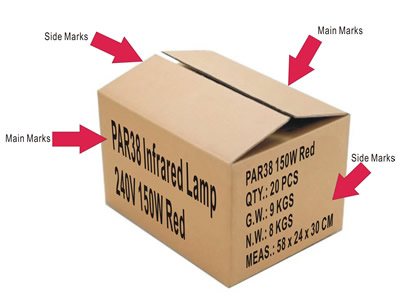A few days after placing my first private label order to sell on Amazon FBA, I received this email from my supplier.
“Please send us your shipping mark as soon as possible.”
With no manufacturing or importing experience in my background, I was clueless. I’d listened to endless podcasts and read numerous blog posts on private labeling, but no one had ever mentioned this. I Googled this elusive phrase, but didn’t come up with much information. Finally, a Google image search helped point me in the right direction. I’m happy to report that with my rudimentary knowledge, I created my very own shipping mark and my products made it safely to the USA with the provided information. If you have a background in manufacturing or importing, please feel free to let me know if I’m off track here.
If you use a freight forwarder to receive your products, they should be able to help you create a shipping mark with the information you need. Pallet shipments may require different information on its shipping marks.
What Is A Shipping Mark?
A shipping mark is simply a mark on the outside of the exterior shipping carton of an item being exported. The shipping mark provides information, such as the size of the item, the country where it was manufactured, and the number of items in the carton, for example. If you’ve ever bought a carton of something, chances are you’ve seen a shipping mark on the side of the cardboard packaging.
The information on the carton should match the information on the packing list sent by your supplier. There may be other information listed that is used to manage your items when you receive them (such as in a warehouse).
What Should A Shipping Mark Include?
At the minimum, your shipping mark should include:
- Your company name and/or logo
- Your order number or product number
- The net weight and gross weight of 1 carton (net weight is the weight of the item without a container or packaging; gross weight is the weight of the entire contents of the carton)
- The dimensions of 1 carton
- The destination of your carton
Your shipping mark should also include the number of the carton and total number of cartons (such as 1/50, 2/50, 3/50). In my case, the number of cartons and total was handwritten by the manufacturer but you could have it printed with the shipping mark.
I also noted that the contents were Made In China.
What Else Can You Include?
You can also instruct your manufacturer to include internal information that would be helpful to organize your inventory in your storage space or warehouse. If you are selling a product variation of a different color or size, you can list the color on the shipping mark (ie, Color: Black or Size: Large). Basically, any information you’d want to keep track of the items when you receive them should be included.
I don’t have experience with this, but some manufacturers may paste a list with the shipping mark on the carton or include an RFID chip or barcode with the information embedded. In my case, the shipping mark was printed directly on the package.
When Do You Need the Shipping Mark?
In my case, my supplier required the shipping mark before the items were produced so that the completed product could be placed into the marked boxes.
Shipping Mark Template Sample
I used the following shipping mark template:
Vendor Name: [your business name]
Destination: [country where your business is located]
G.W.: [gross weight]
N.W.: [net weight]
Dimensions: [size of your carton]
Order Number: [obtain from your supplier]
Product Description: [your product name]
Carton Number: of 50 [or however many cartons you have]
Country of Origin: [manufacturer’s location, such as China]
